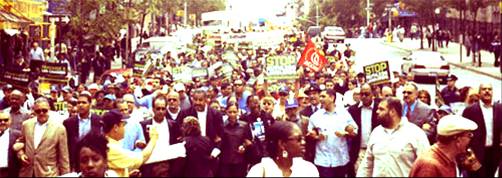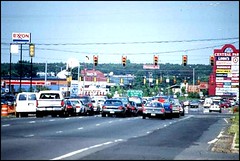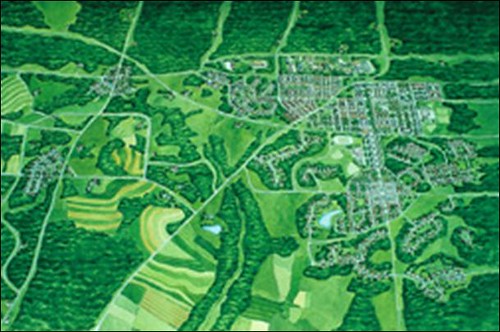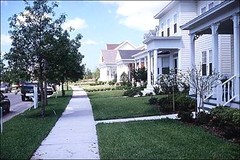LULUs, NIMBYs, and BANANAs: just say no to just saying NOPE

Posted December 12, 2007 at 7:50PM
I love these acronyms:
LULU – Locally Unwanted Land Use.
NIMBY – Not In My Back Yard.
NOPE – Not On Planet Earth (!).
And my absolute favorite:
BANANA – Build Absolutely Nothing Anywhere Near Anything.
I hope you’re at least chuckling. ’tis the season to be jolly and all that. But all too often this describes the position of environmentalists and our well-meaning “troops on the ground” when it comes to proposed land development. And, in fact, it may be the absolute worst thing we can do.

Let’s admit up front that we enviros are really, really good at saying no. Arguably, our entire movement has been built on a foundation of identifying problems, publicizing them until we scare the bejeezus out of people, and then marshaling all our resources to stop them. We are great at being critics and grinding things to a halt. And we’ve built and refined an entire body of law to help us do just that. Heck, if you were to know NRDC only through our direct mail, you might think it’s the only thing we do.
Me too, by the way. I lash out against sprawl all the time, and I was in attack mode almost exclusively when I began my career at NRDC in the holy war known as forest policy. The planet has benefited from our criticisms and our advocacy, without a doubt. I’m rather proud of the role I played in killing some really ugly logging plans in the national forests.
 But where we haven’t been nearly as good or as successful is in identifying the things we should say yes to and educating our environmental constituency on the importance of doing so. Don’t believe me? With apologies to some very good friends, just try to get a straight answer from an environmentalist to the question of what we really should do with nuclear waste.
But where we haven’t been nearly as good or as successful is in identifying the things we should say yes to and educating our environmental constituency on the importance of doing so. Don’t believe me? With apologies to some very good friends, just try to get a straight answer from an environmentalist to the question of what we really should do with nuclear waste.
When it comes to land development, we need to keep saying no to a lot of it. But we can't just say no. In fact, it couldn’t be more important to identify the best practices and say yes to them. Here is what is going to happen in the US over the next 25 years, whether we like it or not, in some fashion:
- 70 million more people, roughly the current population of California, New York, and Florida combined
- 40 million new jobs
- 32 million new households
- 50 million new and replacement homes
- 78 billion square feet of new and replacement nonresidential space
 The replacement part of the mix is interesting and something most people don’t think about. At the same time that we are building, we are losing buildings because they become structurally unsound or unsuited to any viable purposes. It apparently happens at an amazing rate for commercial property. This presents a challenge, but it’s not all bad: it also gives us an opportunity to rebuild, and to do it better; and it gives us redevelopment sites so we don’t have to build as much on currently undeveloped land.
The replacement part of the mix is interesting and something most people don’t think about. At the same time that we are building, we are losing buildings because they become structurally unsound or unsuited to any viable purposes. It apparently happens at an amazing rate for commercial property. This presents a challenge, but it’s not all bad: it also gives us an opportunity to rebuild, and to do it better; and it gives us redevelopment sites so we don’t have to build as much on currently undeveloped land.
These numbers come from the highly enlightening research of Arthur C. Nelson of Virginia Tech. As Nelson puts it, “more than half the built environment of the United States we will see in 2025 did not exist in 2000.”
 We can’t wish this away, any more than Mulder and Scully could wish away the black ooze on the X-Files. It WILL go somewhere. And if we – and local environmental activists – just say no to each increment of this development as it occurs, all we will do is spread it around to the places that complain the least, and the result will be even more chaotic patterns of sprawl than we have now. Given current trends in development patterns, resulting automobile use, natural area consumption, and greenhouse gas emissions, just to name a few of the consequences of the wrong kind of development, and all of which are bad enough as it is, we will be inviting disaster and it will be our own fault.
We can’t wish this away, any more than Mulder and Scully could wish away the black ooze on the X-Files. It WILL go somewhere. And if we – and local environmental activists – just say no to each increment of this development as it occurs, all we will do is spread it around to the places that complain the least, and the result will be even more chaotic patterns of sprawl than we have now. Given current trends in development patterns, resulting automobile use, natural area consumption, and greenhouse gas emissions, just to name a few of the consequences of the wrong kind of development, and all of which are bad enough as it is, we will be inviting disaster and it will be our own fault.
We environmentalists need to stop coaching people on how to just say no and start coaching them also on what to say yes to and how to say it so it happens. That’s what smart growth is all about.